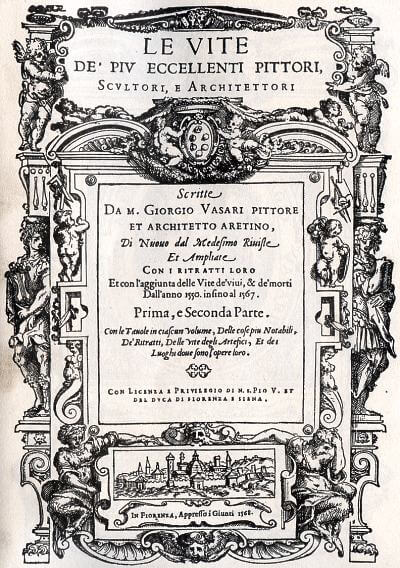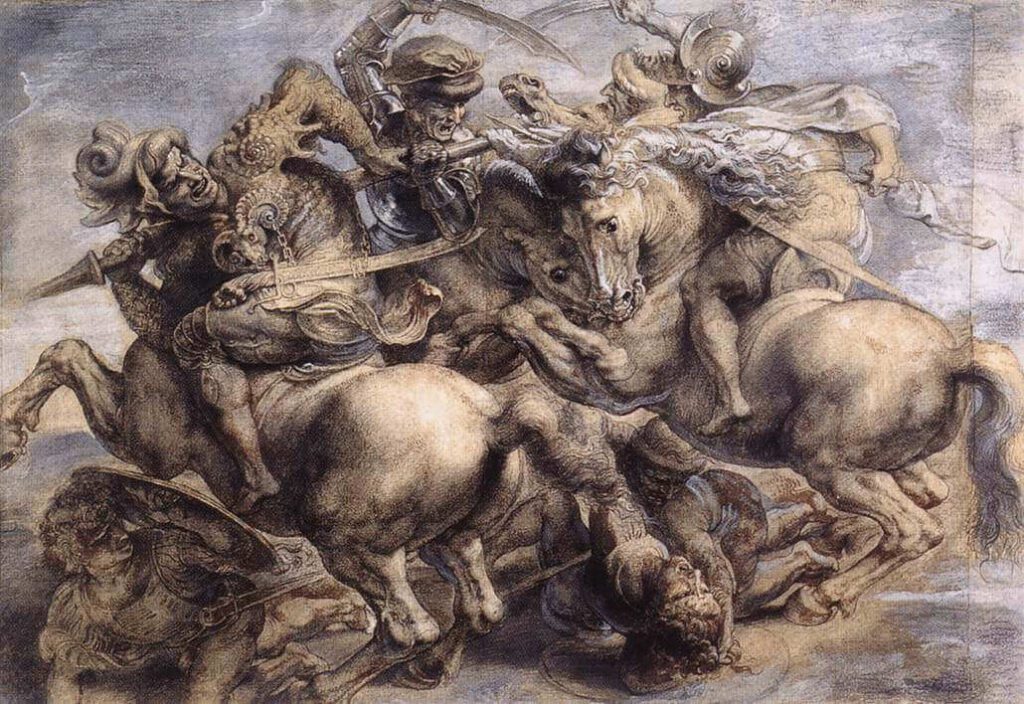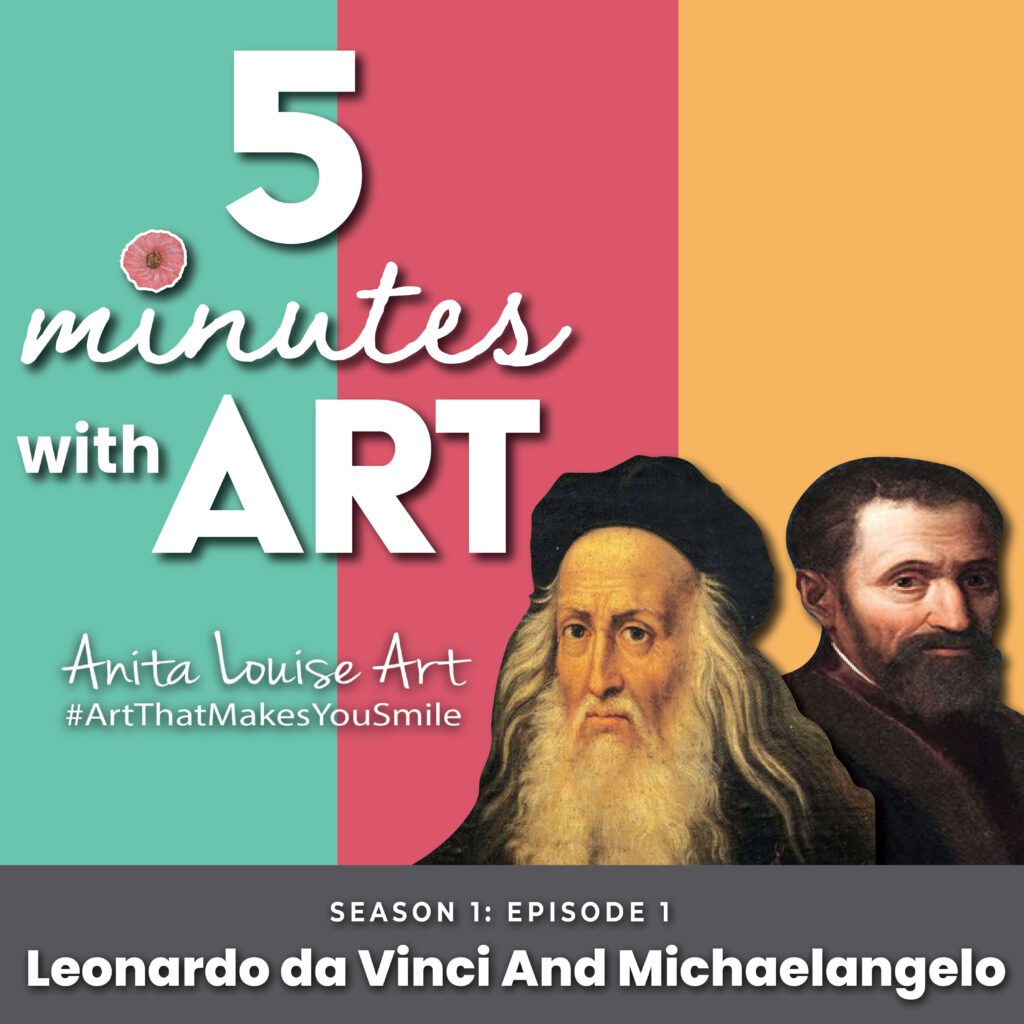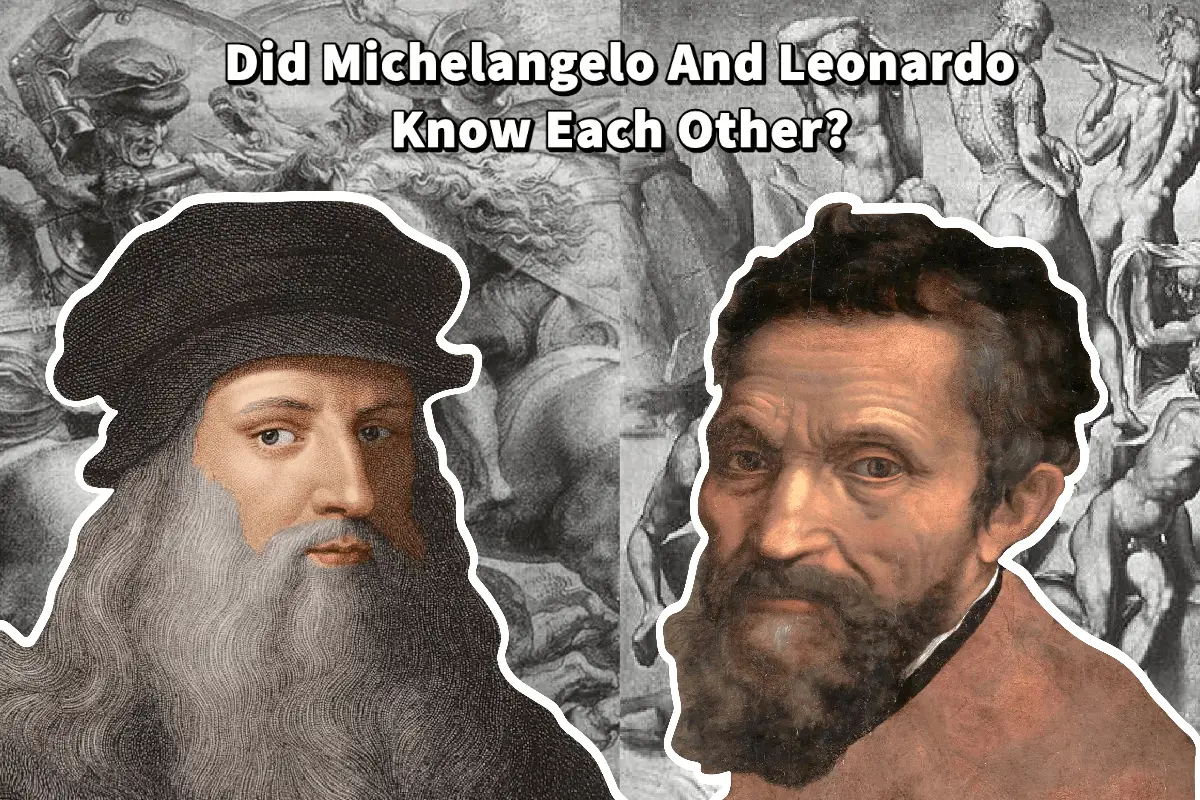Michelangelo and Leonardo da Vinci are considered two of the greatest artists ever lived. They both lived in Florence, Italy, during the same time.
Michelangelo and Leonardo da Vinci knew each other but were considered bitter rivals. Leonardo da Vinci and Michelangelo knew each other, but they did like each other. They were both asked to do a commission on the Council Hall of the Palazzo Vecchio and were supposed to work side-by-side; the project was never completed.
Table of Contents
- The Rivalry Of Leonardo da Vinci And Michelangelo
- The Leonardo da Vinci And Michelangelo Contest
- The Commissions Of Leonardo And Michelangelo
- Leonardo da Vinci and Michelangelo: 10 Reasons Why They Reign Supreme in the Renaissance Era
- Frequently Asked Questions
- Related Questions
The Rivalry Of Leonardo da Vinci And Michelangelo
Leonardo da Vinci and Michelangelo knew each other but were in a bitter rivalry and painting contest. The rivalry and painting contest is one of the most exciting stories of the Renaissance era.

In 1569, Giorgio Vasari wrote his iconic book “The Lives of the Most Excellent Painters, Sculptors, and Architects.” In this book, Giorgio gives first-hand knowledge of many of the painters and sculptors of the Renaissance, including the lives of Leonardo da Vinci and Michelangelo.

In the early 1500s, Michelangelo and Leonardo were commissioned to paint side-by-side battle scenes in the Palazzo Vecchio Council Hall in Florence, known today as the Salone dei Cinquecento. These two great artists were told to paint different mural scenes on opposite sides of the hall; they were to paint the battle scenes simultaneously and work side-by-side in the same building.
At the time, Michelangelo was only 29 years old when the commission came to him. He was born in 1475 and studied sculpture under Lorenzo de Medici. Michelangelo had completed the statue of Pieta in St Peter’s in Rome, and his famous statue of David was installed outside the Palazzo Vecchio.
Also, Leonardo was in his early 50s at the time of this commission. He had finished the Mona Lisa painting and became a prominent painter in Florence and throughout Europe. He would have felt that his talent and abilities were already well established, and he did not need to prove anything to anyone.
The Leonardo da Vinci And Michelangelo Contest
Both Leonardo and Michelangelo were commissioned to paint a vast battle scene on the walls of the Council Hall. They were to work side-by-side; many saw this as a contest between these two great artists to see who was the most significant artist.
This art commission was considered one of the most important and significant art commissions of the Renaissance era. Leonardo and Michelangelo were to work in the same hall but on opposite walls.

Leonardo, in particular, saw this commission as a kind of competition. He was much older and well-established; he felt he had nothing to prove to anyone.
Leonardo was commissioned to paint “The Battles of Anghiari,” a scene from the 15th-century wars between Florence and Milan.

After receiving his commission, a much younger Michelangelo was commissioned to paint “The Battle of Cascina” on the opposite wall.
Michelangelo got the commission the same month Leonardo revised his contract with the Signoria of Florence to return the date to complete his painting. Leonardo had accepted his commission first, and then after he was working on the mural, Michelangelo was also given a commission.
Michelangelo’s statue of David was installed outside the Palazzo Vecchio when we received the commission. For Leonardo, this showed that he had a rival, and a sort of competition had begun.
Many saw these two commissions to paint these battle scenes as a competition. But with the competition came other human emotions, such as paranoia, jealousy, and rage.
Michelangelo had very little time for Leonardo. He made his dislike of Leonardo very clear, and his disapproval was so apparent that he left Florence and went to France to get away from him.
Leonardo made a lot of notes in his notebook to show how much he disliked Michelangelo. He was known to criticize Michelangelo and disregard his art and artistic abilities.
The Commissions Of Leonardo And Michelangelo
Even more interesting is what has happened to these grand murals that both Leonardo and Michelangelo were commissioned to paint. Neither of them completed their murals.
We do not know why the murals were never even started. For both Michelangelo and Leonardo da Vinci, this commission to paint the murals in the Palazzo Vecchio Commons Hall would have been significant.

Listen To Our Podcast About The Rivalry Of Leonardo da Vinci And Michelangelo below or by clicking here.
The Battle Of Anghiari By Leonardo da Vinci
The Battle of Anghiari is considered by many to be “The Lost Leonardo.” Leonardo’s sketches to plan the mural are the only thing left of this painting.
The central theme of the painting would have depicted four men riding horses while raging war and engaging in a fierce battle. In true Leonardo fashion, these studies give vivid details of what he planned to paint.
The Battle of Anghiari is called “The Lost Leonardo,” There was also some controversy if Leonardo painting the painting, but it was later painted over. Many believe that Leonardo’s portrait was painted over when Giorgio Vasari painted the murals on the walls.
However, modern scanning techniques have revealed that Leonardo never painted the murals. Instead, he only planned the mural but never did the actual painting.
Perhaps this is why in his 1569 book on the Renaissance, Giorgio Vasari wrote this about Leonardo da Vinci:
“Truly marvellous and celestial was Leonardo, the son of Ser Piero da Vinci; and in learning and in the rudiments of letters he would have made great proficience, if he had not been so variable and unstable, for he set himself to learn many things, and then, after having begun them, abandoned them.”
Giorgio Vasari
As we can see from this write-up, Giorgio Vasari felt Leonardo was a marvelous artist. Still, he seems to have a reputation for not finishing some of the art or commission he was given during his lifetime. Leonardo was known to be a notoriously slow and methodical painter.
We do not know why Leonardo did not finish the mural of The Battle of Anghiari. From the recent scans of the walls, he never painted the mural but only did the preliminary sketches.
The Battle of Cascina by Michelangelo
The other wall commissioned to be painted by Michelangelo was the Battle of Cascina. Like Leonardo, Michelangelo only completed the preliminary drawings for the mural.
He did not finish the mural because he was called to Rome by Pope Julius II to start the work on the Pope’s tomb.
We know that Michelangelo did the sketches, but we do not understand why he never completed the mural. Some feel it was because of the tension that was going on between Leonardo and Michelangelo; it could be that never Leonardo and Michelangelo wanted to be part of this contest or competition, so they decided not to finish the work and participate in a contest people were trying to force them into.
Why these two murals were commissioned by never finished remains one of the great mysteries of the Renaissance era.
Leonardo da Vinci and Michelangelo: 10 Reasons Why They Reign Supreme in the Renaissance Era
The Renaissance, a period of immense cultural and artistic revival, gave the world a myriad of creative geniuses.
Among them, Leonardo da Vinci and Michelangelo shine the brightest. Their legacies are not confined to their time but continue to resonate in the corridors of art even today.
Why do these two maestros hold such an esteemed position in the pantheon of great Renaissance artists? Here are ten compelling reasons:
- Timeless Masterpieces: Both Leonardo and Michelangelo created artworks that are nothing short of iconic. Be it Leonardo’s “Mona Lisa” or Michelangelo’s frescoes in the Sistine Chapel, these pieces have stood the test of time, capturing hearts and minds for centuries.
- Pioneering Techniques: The duo didn’t just adhere to existing artistic techniques; they revolutionized them. Leonardo’s sfumato technique and Michelangelo’s sculpting prowess brought a new dimension to art, making it more lifelike and evocative.
- Versatility: While many artists excel in a single domain, Leonardo and Michelangelo showcased versatility. Leonardo’s forays into anatomy, engineering, and botany complemented his artistic endeavors. Similarly, though a sculptor at heart, Michelangelo painted, wrote poetry, and dabbled in architecture.
- Depth of Emotion: Their artworks are not just visually appealing; they delve deep into the human psyche. Leonardo’s “The Last Supper” captures a gamut of emotions, while Michelangelo’s “Pieta” is a heart-wrenching portrayal of sorrow.
- Revolutionizing Portraiture: Before Leonardo, portraits often lacked vitality and depth. His unique approach, emphasizing character and emotion, paved the way for future artists, making portraiture a more nuanced art form.
- Attention to Detail: Anyone observing the intricate veins on Michelangelo’s “David” or the detailed background of Leonardo’s “Mona Lisa” can attest to their unparalleled attention to detail. This meticulousness brought their works to life.
- Anatomical Precision: Leonardo’s fascination with the human body led him to produce detailed anatomical sketches, elevating the accuracy and realism in his paintings. Similarly, Michelangelo’s sculptures deeply understand human musculature and form.
- Changing the Course of Art: Both artists played pivotal roles in shaping the High Renaissance. Their innovations in perspective, anatomy, and emotion introduced fresh paradigms, forever changing the trajectory of Western art.
- Enduring Influence: Centuries later, both Leonardo and Michelangelo continue to inspire. Artists, architects, and even scientists draw from their works, proving their lasting impact on diverse fields.
- Art as a Reflection of Humanity: Art wasn’t just about aesthetics for both maestros. It was a mirror to humanity, reflecting our strengths, vulnerabilities, emotions, and aspirations. This profound understanding and representation of the human experience make their works universally relatable.
Leonardo da Vinci and Michelangelo aren’t just artists; they are monumental figures whose contributions transcend time and disciplines. Their legacies are a testament to the Renaissance’s indomitable spirit and the art’s enduring power to reflect, inspire, and elevate.
Anita Louise Art is dedicated to art education, great artists, and inspiring others to find and create their art. We love art that uplifts and inspires. #ArtToMakeYouSmile! #ArtToMakeYouHappy!
If you are interested to see any of my art, you can find out more by clicking here. If you are interested in what inspires me and my paintings, you can discover more by clicking here.
We have a free newsletter and would love you to be part of our community; you can subscribe to the newsletter by clicking here. If you have any questions, I would be happy to talk to you at any time. You can reach me, Anita, by clicking here.
Subscribe to our Anita Louise Art YouTube Channel filled with great videos and information by clicking here.
Join us for our podcast “5 Minutes With Art.” Spend just 5 minutes a week with us to discover and learn about great art and artists. You can find out more about our podcast by clicking here.
Frequently Asked Questions
Did Da Vinci influence Michelangelo’s work?
While the works of earlier Italian artists influenced Michelangelo, there is no clear evidence that Da Vinci had a direct influence on his style.
Did Michelangelo and Da Vinci share any patrons or clients?
It is possible that Michelangelo and Da Vinci may have shared some patrons or clients, as they both worked in Italy during the same time period.
Did Michelangelo and Da Vinci compete for the same commissions?
It is possible that Michelangelo and Da Vinci may have competed for some of the same commissions, as they both worked as artists in Italy during the Renaissance.
Did Michelangelo and Da Vinci have different styles of art?
Michelangelo and Da Vinci were both known for their unique styles of art, with Michelangelo being known for his monumental sculptures and Da Vinci for his innovative use of perspective.
Did Michelangelo and Da Vinci have different artistic philosophies?
While Michelangelo and Da Vinci may have had different approaches to art, their philosophical views on art are not well-documented.
Did Michelangelo and Da Vinci have any influence on each other’s art?
: While there is no clear evidence that Michelangelo and Da Vinci directly influenced each other’s art, they were both part of the same artistic milieu in Italy during the Renaissance.
Did Michelangelo and Da Vinci leave behind any joint artistic legacy?
There is no joint artistic legacy left behind by Michelangelo and Da Vinci, although their works continue to be celebrated as some of the greatest achievements of the Italian Renaissance.
Did Michelangelo ever mention Da Vinci in his writings or letters?
There is no record of Michelangelo mentioning Da Vinci in his personal writings or letters.
Related Questions
What Did Leonardo da Vinci Contribute To The Renaissance?
Leonardo da Vinci made many contributions to the Renaissance in art, science, engineering, medicine, and architecture. He was a keen observer who wrote down a lot of what he discovered in his notebooks. His artistic techniques changed how artists painted and influenced many other Renaissance artists.
By clicking here, you can learn more by reading What Did Leonardo da Vinci Contribute To The Renaissance?.
What Did Leonardo da Vinci Contribute To Medicine?
Leonardo da Vinci contributed a lot to the medical field of study. His work contributed to our understanding of anatomy, medical physics, biomedical engineering, and neuroscience. As an artist and scientist, he was fascinated with the human body.
By clicking here, you can learn more by reading What Did Leonardo da Vinci Contribute To Medicine?.

